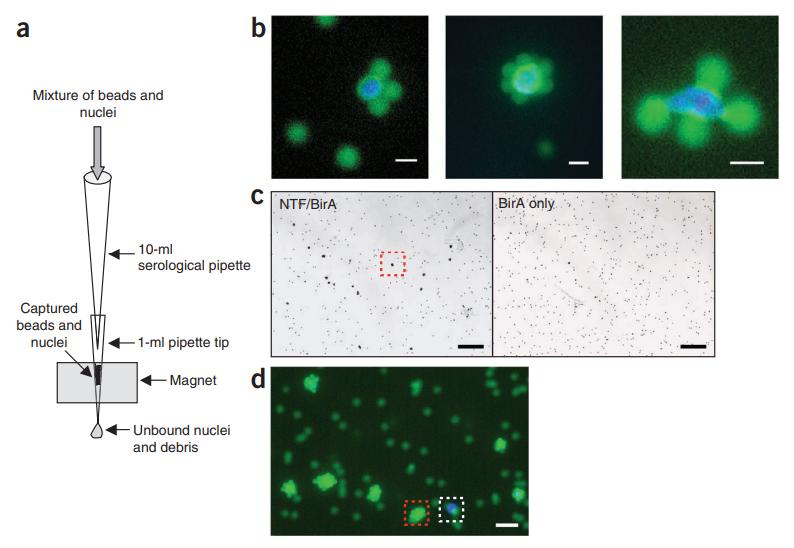Lifeasible's researchers can provide customers with cell type-specific nuclei purification services, primarily through the INTACT (Isolation of nuclei tagged in specific cell types) method. The method is based on standard genetic techniques, using only common laboratory equipment.
Genomic studies of cell differentiation and function in whole organisms depend on the ability to isolate specific cell types from tissues. Deal et al. developed the INTACT method that allows affinity separation of nuclei from individual cell types in tissues, thus avoiding the problems associated with mechanical purification techniques.
 Figure 1. Purification of tagged nuclei with the INTACT system. (Deal et al., 2011)
Figure 1. Purification of tagged nuclei with the INTACT system. (Deal et al., 2011)
When purifying specific nuclei, all plant tissues need to be mashed, all nuclei extracted, and mixed with streptavidin-coated magnetic beads, in which streptavidin-coated magnetic beads will firmly bind biotin. The nucleus-magnetic bead suspension is then injected into a simple column. The nuclei of cells from other cell types would be flushed away directly so that the purified genetic material of that cell type could be captured.
Purifying the labeled nucleus involves preparing the total nucleus from the tissue, binding streptavidin-coated magnetic beads to the labeled nucleus, and collecting the bead-bound nucleus by allowing a mixture of magnetic beads and nuclei to flow through the magnet. The binding of Streptomyces avidin beads to biotinylated nuclei is done in a small volume to maintain the proximity of beads to nuclei, thus improving the binding efficiency.
Once the binding of the bead to the nucleus is complete, the mixture needs to be diluted 10 times to obtain a high-purity nucleus before the bound nucleus is collected on the magnet. At the same time, two rounds of flow purification were used to ensure the highest purity of the cores.
The purity of the nuclei after separation can be assessed at the end of the experiment by calculating the percentage of contaminated nuclei in the final preparation. By staining the total nuclear preparation with a DNA-binding fluorescent dye at the beginning of the procedure, purity can be determined by measuring the ratio of beaded nuclei to unbound nuclei that are free of beads and have fluorescence.
1. Success in specific nuclei purification begins with high-quality total nuclear preparation and efficient capture of the beaded nuclei on the magnet without contamination by other nuclei and debris.
2. For cell types with very low abundance, more tissue may be needed. If this is the case, purity may be reduced by the increased number of debris and contaminated nuclei in the flowing column. This can be overcome by reducing the column flow rate, increasing the volume of the diluted nuclear mixture prior to flow purification, or simply performing multiple smaller-scale purifications in parallel.
If you are interested in our purification services for cell type-specific nuclei, or if your products need to be purified, please feel free to contact us, and our technicians and scientists will customize customized project solutions for you.
Reference